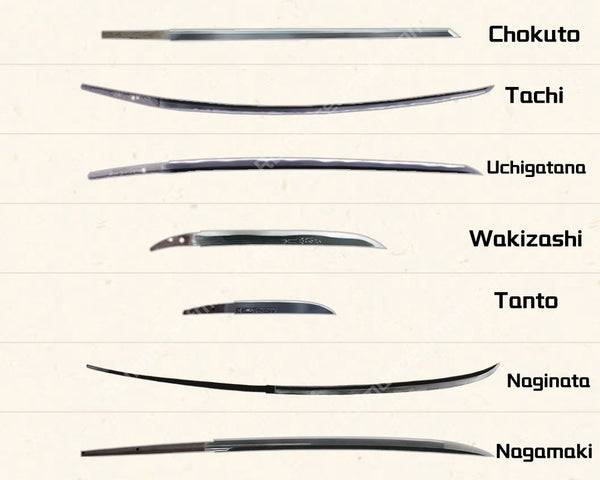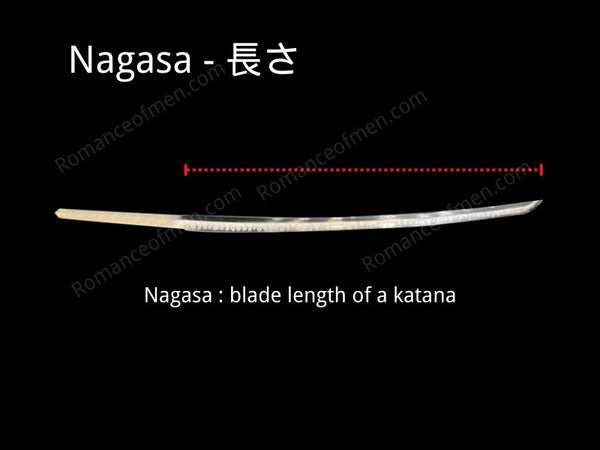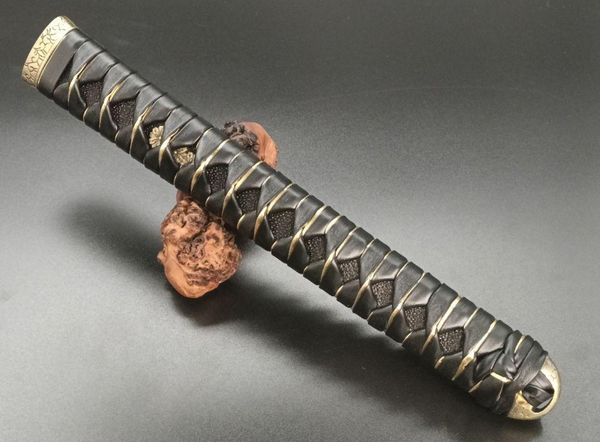how long is a katana (and how long it should be for you)
The katana is a legendary sword, known for the great craftsmanship and historical value it carries along with it. The length of a katana makes many people curious. This article will introduce the history behind the katana length, how to measure it correctly, how to find the right length for you and some fun katana in history.
Table of Content
- How long is a Katana (Uchigatana)
- Other Katana Blade Measurements
- “Houryou” 法量 Traditional way of measuring Katana
- Katana Blade Length Standard
- Find the best Katana blade length for you
- Biggest / Longest katana in history
How long is a Katana (Uchigatana)

Common Katana Length
- Overall Length (Including Saya): Approximately 100 cm (39.4 inches).
-
Katana Blade Length (From Kissaki to Munemachi, excluding Habaki): Typically between 60-70 cm (23-27 inches).
- In Japan, there are no strict regulations regarding blade length. However, swords with blades 60 cm or longer are generally classified as katana. Blades exceeding 90 cm are often referred to as odachi.
- Katana Handle Length (From Fuchi to Kashira): Generally about 25-30 cm (10-12 inches).
- Katana Saya Length: Usually about 5 cm (2 inches) longer than the blade to allow proper fit and a small amount of extra space to protect the tip.
Generally speaking, the total length of a traditional katana is about 39.4 inches (100 cm), with the blade itself measuring about 27.6 inches (70 cm) in length. This is the average length, it's often to see katana with customized blade length.
Key things to understand:

By Katana, people usually refer to Uchigatana (打刀), because this is the most popular and famous one. There are actually many types of Katana, like Tachi 太刀, Wakizashi 脇差, tanto 短刀 etc, they are all classified as Katana (Japanese Swords).
Katana (Uchigatana) Blade Length

Average blade length for Katana (Uchigatana) is about 60-70 cm (23-27 inches). This is the most common length, mostly due to the shogunate regulations of the Edo period, carrying swords was acceptable only upon formal consent and varied in length depending on one's social or official standing.
Initially, the authorized blade length was about 69.6 m (27.4 inches) for those engaging in martial arts or swordsmanship until the era of the third shogun, Tokugawa Iemitsu. Later, during the time of the fourth shogun Tokugawa Ietsuna, this limit was revised to 68.2 cm (26.8 inches).
Katana (Uchigatana) Handle Length

Average handle length for Katana (Uchigatana) is about 25-30 cm (10 - 12 inches). The length of the handle is crucial as it provides the necessary grip and control, especially when the blade is long or heavy.
Katana length comparison:

| Sword Type | Blade Length (cm/in) | Total Length (cm/in) Approx. |
|---|---|---|
| Uchigatana | 60 - 73 cm / 23.6 - 28.7 in | 100 - 110 cm / 39.4 - 43.3 in |
| Tachi | 70 - 80 cm / 27.6 - 31.5 in | 100 - 120 cm / 39.4 - 47.2 in |
| Wakizashi | 30 - 60 cm / 11.8 - 23.6 in | 60 - 80 cm / 23.6 - 31.5 in |
| Tanto | 15 - 30 cm / 5.9 - 11.8 in | 25 - 50 cm / 9.8 - 19.6 in |
Uchigatana: A versatile, mid-length Japanese sword, primarily used by samurai in feudal times for close combat, especially indoors. Blade length is 60 to 73 cm (23.6 - 28.7 in), total length around 100 to 110 cm (39.4 - 43.3 in).
Tachi: Predating the Uchigatana, used by samurai on horseback for slashing attacks. It has a longer, curved blade, about 70 to 80 cm (27.6 - 31.5 in), with a total length of roughly 100 to 120 cm (39.4 - 47.2 in). Tachi is wear with edge downward, as oppose to Uchigatana wearing with edge upward.
Wakizashi: A sidearm for samurai, usually paired with the Uchigatana, symbolizing status. Used in tight spaces, it has a blade length of 30 to 60 cm (11.8 - 23.6 in) and a total length of 60 to 80 cm (23.6 - 31.5 in).
Tanto: A short sword or large knife, used for stabbing and slashing. Carried for self-defense and daily tasks, its blade length is 15 to 30 cm (5.9 - 11.8 in), with a total length of 25 to 50 cm (9.8 - 19.6 in).
Other Katana Blade Measurements:
Katana Blade Curve: Sori 反

The 'sori' or curvature of a Japanese sword is the maximum distance measured between a straight line connecting the tip/edge and the spine area, and the back/spine (Mune 棟) of the sword.
The depth of the 'sori' varies depending on the combat style and era, could as flat as 0.9 cm (0.35 inch) or as deep as 3.9 cm (1.5 inches). Usually Tachi is more curved than Uchigatana.
Katana Blade Width : Motohaba 元幅 and 先幅 Sakihaba
The width of a katana blade is around 2.9 to 3.2 cm (1.14 to 1.25 inches). The width is measured between the blade's edge (Ha) to the backside (Mune) of the blade. The width of a katana is called 'Motohaba 元幅' in Japanese, and the width near the tip, is called 'Sakihaba 先幅'.
Assuming the blade's thickness is the same, differences in width affect performance. A narrower width, with a larger angle at the tip, increases the reactive force when striking but reduces friction due to less blade surface contact. Conversely, a wider width disperses the reactive force from the target but increases friction resistance. In terms of strength, a wider width is advantageous for a Japanese sword as it helps disperse the reactive force on the blade.
“Houryou” 法量 Traditional way of measuring Katana
Traditionally, measuring a katana sword is called “Houryou” 法量. The term originally referred to the measurements of Buddhist statues. It is said that the reason why this term came to be used to measure the size of Japanese swords, and became established in this usage, is because katanas were once regarded as noble existences, just like gods and Buddhas. Houryou are usually for the katana blade length (刃長 nagasa), blade curvature (反 sori) , blade width (Motohaba元幅 ) etc,
To begin, We should know that the unit to measure Katana sword, is Shaku (尺), in today’s unit, one shaku is about 30cm (11.8 In). 1 Shaku is about a normal man’s length of his forearm from elbow to the tip. The shaku is further divided into smaller units:
1 shaku = 10 sun 寸
1 sun = 10 bu 分
1 bu = 10 rin 厘
The blade length, in Japanese is called 刃長 (Nagasa), nagasa was length of measuring a straight line from the kissaki towards the Munemachi groove at the Habaki's back. There were no official standard or regulation for the nagasa before the Edo Period. For a standard blade length, the Uchigatana (打刀), popular since the Edo period, typically measures between two shaku three sun and two shaku four sun (about 70-73 cm / 27-28 in). This length was considered most manageable for samurai, especially considering the average height of men during the Edo period was around 155 cm (5 feet 1 inches).
Katana Blade Length Standard
As we mentioned earlier, there was a regulation for katana blade length in Edo period. However, during that time, the common people hardly adhered to this restriction. Because if you are a tall person, you might find 70cm (27.6 inc) blade length a little short. For example the great swordsmen Miyamoto musashi, he is about 182cm (6 feet) tall, which considered very tall in his time, his three beloved swords's blade length are:
Nameless (Muimei) 無銘金重: Blade length of 70 cm (27.6 in).
Izuminokami Fujiwara Kanesada 和泉守藤原兼重: Blade length of 81.5 cm (32 in) , total length of 117.5 cm (46.2 in).
Ryōgai 了戒: Blade length of 85 cm (33.4 in).
So don’t worry if your katana’s length is “standard” or not, because the best katana length for each person is different. your height, the length of your arms measured from fingertip to fingertip, your gender, your age, training group, and your school, these factors determine your most suitable katana blade length.
Find the best Katana blade length for you
For iaido practitioner, a good general guide for choosing a sword's blade length is to match it to the user's height, though this practice can vary between different schools and dojos. For women and aikido practitioners who use the sword in their independent practice, it's recommended to choose a blade that is 0.5 shaku shorter than the length typically recommended for men of the same height. This consideration helps with the ease of drawing the sword.
For iaido practitioner, to help you find your best length, here is a table indicating the length of the katana corresponding to the individual's height:
| Height (Male/Female) | Recommended Blade Length (cm/in) | Recommened Handle Length (cm/in) |
|---|---|---|
| 150 cm ~ 155 cm | 2 shaku 2 sun (66.6 cm / 26.2 in) | 7 sun 5 bu ~ 8 sun (22.7 ~ 24.3 cm / 8.9 ~ 9.6 in) |
| 155 cm ~ 160 cm | 2 shaku 2 sun 5 bu (68.2 cm / 26.9 in) | 7 sun 5 bu ~ 8 sun (22.7 ~ 24.3 cm / 8.9 ~ 9.6 in) |
| 160 cm ~ 165 cm | 2 shaku 3 sun (69.6 cm / 27.4 in) | 8 sun ~ 8 sun 5 bu (24.3 ~ 25.6 cm / 9.6 ~ 10.1 in) |
| 165 cm ~ 170 cm | 2 shaku 3 sun 5 bu (71.2 cm / 28.0 in) | 8 sun ~ 8 sun 5 bu (24.3 ~ 25.6 cm / 9.6 ~ 10.1 in) |
| 170 cm ~ 175 cm | 2 shaku 4 sun (72.7 cm / 28.6 in) | 8 sun 5 bu ~ 9 sun (25.6 ~ 27.3 cm / 10.1 ~ 10.7 in) |
| 175 cm ~ 180 cm | 2 shaku 4 sun 5 bu (74.2 cm / 29.2 in) | 8 sun 5 bu ~ 9 sun (25.6 ~ 27.3 cm / 10.1 ~ 10.7 in) |
| 180 cm ~ 185 cm | 2 shaku 5 sun (75.8 cm / 29.8 in) | 9 sun ~ 9 sun 5 bu (27.3 ~ 28.8 cm / 10.7 ~ 11.3 in) |
| 185 cm ~ 190 cm | 2 shaku 5 sun 5 bu (77.3 cm / 30.4 in) | 9 sun ~ 9 sun 5 bu (27.3 ~ 28.8 cm / 10.7 ~ 11.3 in) |
| 190 cm ~ 195 cm | 2 shaku 6 sun (78.8 cm / 31.0 in) | 9 sun 5 bu ~ 10 sun (28.8 ~ 30.3 cm / 11.3 ~ 11.9 in) |
| 195 cm ~ | 2 shaku 7 sun (81.8 cm / 32.2 in) | 9 sun 5 bu ~ 10 sun (28.8 ~ 30.3 cm / 11.3 ~ 11.9 in) |
There is a calculation formula to estimate the length of a sword based on height. The formula is to multiply the height by 0.43, and since this is in centimeters, it is divided by 30.3 to convert it into shaku, a traditional Japanese measurement unit. However, it is important to note that this is a general guideline, and the appropriate length and weight of a Katana may vary depending on the individual's preferences and physique. It should also be considered that the length and weight of the sword may differ between males and females.
For example a 170 cm ((5 feet 1 inches) tall male:
170 x 0.43 ÷ 30.3 = 2.41 Shaku (72.7 cm / 28.6 in)
Biggest / Longest katana in history:

The sword renowned as the world's largest Japanese sword is the "Haja-no-Otachi"破邪の御太刀 housed in Hanaoka Hachiman Shrine in Shimotsu City, Yamaguchi Prefecture. Its blade length measures an astonishing approximately 345.5 cm (136 in), with overall length 465.5 cm (183 in) and weighs a staggering 75 kg (165 lbs).
To put it into perspective, 345.5 cm (136 in) is roughly the length of two tatami mats aligned vertically. (Note: Tatami is a traditional Japanese flooring material, and this measurement is based on the dimensions commonly used in the Kanto region.)
Indeed, the "Haja-no-Ontachi" was not wielded by samurai in actual combat. According to records passed down at Hanaoka Hachiman Shrine, the sword was dedicated by local residents during the Shikinen Sengu ceremony in 1859 (Ansei 6). This was a time of increasing external pressure from Western powers, and in the same year, the wave of the "Ansei Purge" by the shogunate was also affecting Choshu (present-day Yamaguchi Prefecture).
Given such a turbulent historical backdrop, the sword was imbued with the wish to "purge evil energy and build a peaceful society."
The master swordsmith responsible for its creation was Fujiwara Kunitsuna. He was accompanied by five apprentices and two assistants. Over one ton of sand iron was used in the production of the sword. During the quenching process, known as “clay tempered," where the heated blade is rapidly cooled with water, it is said that they dammed up a local river to carry out the work.
1 comment
-
Posted on by Carlos Emilio catelliBuenísima información!!





















